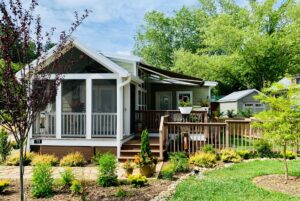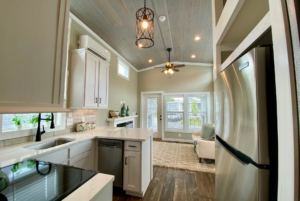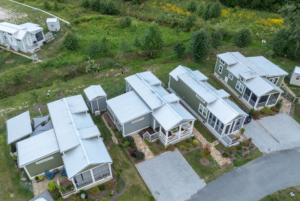If you’re looking for a new home, you might have encountered tiny houses. Tiny homes are part of the tiny home living movement, promoting smaller, more economical living spaces. Most tiny homes remain under 400 square feet, which sounds small, but with flexible spaces and intelligent storage, you can still use your living space!
For those eager to learn more about tiny homes, tiny home living, and what they can offer you and your family, keep reading. We’ll explore what tiny homes are, their key characteristics, benefits, and the challenges of living in these homes. We’ll also talk about who is best suited for a tiny home and what to consider if you want to own one in the future. Before we get into what to expect in these homes, let’s first define tiny homes!
Defining Tiny Homes & Tiny Home Living: What Are They?
As mentioned above, tiny homes are typically less than 400 square feet in size and compact living spaces. You might compare these structures to mobile homes; some tiny homes are even on wheels! Many people have turned to these fantastic properties because they desire to reduce monthly bills and make lifestyles more affordable.
Another major reason people have turned to tiny houses is the desire to embrace more efficient living. Many tiny homes feature flexible spaces, like hallways with hideaway laundry machines or even loft spaces that can double as storage, guest spaces, and more. Depending on the property you find, you might even be able to find one with a front screened-in patio so you can enjoy the great outdoors.

Exploring the Types of Tiny Houses to Choose From
There are two main types of tiny homes to choose from: those on wheels and those built into a permanent foundation. If you’re looking to travel more or want to move your property, you might want to consider a tiny home on wheels. However, foundation tiny homes are best for more stability and a stronger infrastructure for your family’s home. Here’s how they differ:
- Tiny Homes on Wheels: These tiny houses are often built on trailers for mobility, made of lightweight materials, and secure construction to resist movement. Additionally, one of the major benefits of these properties is that they are flexible, meaning you can move them. This also means avoiding the restrictive zoning laws in some parts of the country.
- Tiny Homes on a Foundation: Unlike tiny houses on wheels, these properties are built into a permanent foundation, and they are made with more stable, durable materials. They are much like traditional homes but offer a smaller living space and less square footage, making them easier to maintain. You also enjoy better flexibility as you add utilities and other necessary features to your home.
Now that you know the two main types of tiny homes, it’s time to explore the main features of these properties that make them distinct from other kinds of properties.
The Key Characteristics of Tiny Homes
Tiny homes, despite being on wheels or a permanent foundation, usually have the same features throughout. Expect a minimalist design that focuses on essential living while still including elements like stainless-steel appliances and other modern amenities.
Furthermore, another critical aspect of tiny homes and tiny home living in general that sets them apart is their clever use of storage. The flexibility that these properties present allows you to enjoy multipurpose areas, compact appliances, and even eco-friendly living.
Eco-friendly features are not always a standard part of tiny homes as they are constructed, but many builders are turning to this trend. They continue to make properties out of sustainable materials and more to help reduce energy. That way, your new home not only saves you money but also protects the planet, too!

What are the Benefits of Tiny Homes?
While many people might argue that tiny homes are not the best option for a home today, there are many reasons to consider them. Some of the benefits of choosing a tiny house are obvious: reduced living costs, flexibility, and even the opportunity to live a minimalistic lifestyle. Let’s take a look at these benefits in detail and what you might enjoy if you choose to purchase a tiny home and embrace tiny home living:
- Simple Living: With a minimalist floor plan, you can focus on decluttering and only living with the essentials—including some necessary amenities like modern appliances!
- Reduced Living Costs: If you’re looking to lower your mortgage or rent, tiny homes offer you a cost-effective lifestyle that helps you save for other concerns.
- Mobility: If you choose to purchase a tiny house on wheels, you can enjoy more flexibility whether you want to relocate or travel around and see the country.
- Community Focus: For those purchasing a home like the ones available from Simple Life, you’re also purchasing access to a community of like-minded people.
- Environmental Protection: From reducing your carbon footprint to utilizing sustainable materials to lowering your energy consumption, your tiny home helps protect our planet daily.
Are There Challenges to Owning a Tiny Home?
As with any home, there are challenges to owning a tiny home. Many people find that the limited storage can be somewhat of a problem, and it may be hard for them to adjust to living in only 400 square feet or less, mainly if they are used to 2,000 square feet or more!
Another major challenge people find with tiny homes is zoning issues. In several states, tiny homes are treated as mobile homes or RVs, which can sometimes be a problem. Fortunately, some communities—like Simple Life—are here to help you navigate these legal hurdles and can provide exceptional guidance on the zoning laws that apply to your home.
Who Is Best Suited for Tiny Homes?
Anyone can live in a tiny home! It truly is a wonderful option for those looking to downsize and save money on their monthly bills. However, some of the best candidates for tiny homes include individuals and couples, retirees, and those who are committed to sustainability. If this sounds like you, then it might be time for you to find the tiny home of your dreams!
Find Your Tiny Home at Simple Life Today
We hope that this article taught you more about the benefits of tiny homes and whether or not one might be an excellent option for your family. With so many communities to choose from, it can be hard to find the perfect tiny home for you. Visit Simple Life today to see our available houses and communities in North Carolina. We look forward to welcoming you home!
Frequently Ask Questions (F.A.Q.)
What makes a home a tiny home?
A tiny home is typically less than 400 square feet and often features compact living spaces, such as mobile homes on wheels. These homes emphasize efficient living with flexible areas that can serve multiple purposes, like storage and guest accommodations. This is what makes tiny home living unique.
What is the official definition of a tiny house?
A tiny house is typically defined as a small, portable dwelling that is often under 400 square feet, designed to maximize space and promote a minimalist lifestyle.
What is the difference between a small house and a tiny house?
The difference between a small house and a tiny house is that a tiny house typically measures under 400 square feet, emphasizing minimalist living, while a small house is generally larger, often between 400 to 1,000 square feet.
What are the 2 different types of tiny homes?
The two different types of tiny homes are mobile tiny houses, which are often built on trailers for mobility, and stationary tiny homes, which are placed on a permanent foundation.
Can tiny homes survive the winter?
Yes, tiny houses can survive the winter if properly insulated and equipped with adequate heating.






